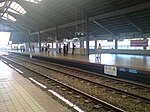Puente Colgante (Manila)
All accuracy disputesBridges in ManilaFormer buildings and structures in ManilaFormer toll bridgesHistory of the Philippines (1565–1898) ... and 5 more
Pages with non-numeric formatnum argumentsSpanish colonial infrastructure in the PhilippinesSuspension bridgesUse Philippine English from May 2021Use mdy dates from May 2021

The Puente Colgante (lit. 'Hanging Bridge'), originally called Puente de Clavería (Clavería Bridge), was a suspension bridge that connected the Manila districts of Quiapo and Ermita across the Pasig River in the Philippines. Designed by Matia, Menchacatorre and Cía., completed in 1852, it was the first suspension bridge in Asia and the first toll bridge of its kind in the Philippines. It was replaced by Quezon Bridge in 1939.
Excerpt from the Wikipedia article Puente Colgante (Manila) (License: CC BY-SA 3.0, Authors, Images).Puente Colgante (Manila)
Villalobos Street, Manila Quiapo (Third District)
Geographical coordinates (GPS) Address Nearby Places Show on map
Geographical coordinates (GPS)
| Latitude | Longitude |
|---|---|
| N 14.5955 ° | E 120.98208333333 ° |
Address
Villalobos Street 249
1001 Manila, Quiapo (Third District)
Philippines
Open on Google Maps









